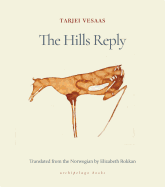
| Publisher: | Archipelago Books | |
| Genre: | Small Town & Rural, Literary, Fiction | |
| ISBN: | 9781939810380 | |
| Pub Date: | December 2019 | |
| Price: | $18 |
| Fiction |
by Tarjei Vesaas, trans. by Elizabeth Rokkan
This final work of experimental, interconnected stories by the legendary Norwegian writer Tarjei Vesaas (1897-1970) is a startling book whose style will challenge as well as invigorate readers. The Hills Reply often shifts forms midway through paragraphs, blending poetry, prose and short vignettes in order to reach an ecstatic truth. The central characters try for the same thing as they attempt communion with the natural world and find transcendence in their austere, everyday lives. The mother in "The Melody" is gripped by the joy of the title, while the narrator of "In the Marshes and on the Earth" is incapable of bridging the gap between himself and the cranes that enrapture him. The characters often exhibit wild behavior as well, as they wander the vast farmlands and landscapes that nearly consume them. Vesaas's writing is deeply impressionistic, as if trying to match these weird and difficult journeys, with the translation by Elizabeth Rokkan emphasizing his lyrical tendencies. Here is a book that loses any pretense of traditional narrative and gains a dreamy quality in return.
Though Vesaas is certainly not an easily accessible writer, fans of Pers Petterson and other Norwegian literary fiction authors will find much to love in this volume. This is the work of an author following his imagination into new territory. By then pushing his prose into Blakean modes of thought, he has crafted an unusual hybrid novel that is immensely rewarding and often stunningly beautiful. The Hills Reply is without a doubt one of the great reading surprises of the year. --C.M. Crockford, freelance reviewer

| Publisher: | Pantheon | |
| Genre: | Cultural Heritage, Family Life, General, Literary, Asian American, Fiction | |
| ISBN: | 9780307907196 | |
| Pub Date: | January 2020 | |
| Price: | $25.95 |
| Fiction |
by Charles Yu
This novel in screenplay format from Taiwanese American author Charles Yu (How to Live Safely in a Science Fictional Universe; Sorry Please Thank You) is a caustic, absurd and endearing exploration of Asian American stereotypes, police procedurals and the immigrant experience.
Yu pulls readers into the spotlight by narrating Willis's inner life in second person, asking the audience to imagine a life as "part of the American show, black and white, except they have no part for yellow." Readers will often find themselves unable to tell reality from television, which is Yu's point in a nutshell. Your name is Willis Wu, but the rest of the world sees you only as Generic Asian Man, if they see you at all. You work as an extra on a police procedural called Black and White, which films in a Chinese restaurant and stars a black actor and white actress. You've worked your way up the ladder from Background Oriental Male and intend to attain the highest on-screen rank for an Asian male: Kung Fu Guy.
As Willis struggles to reach special guest stardom, he must also navigate his relationship with his aging parents. His father, once a Mysterious Kung Fu Master, has dwindled into a confused elderly man. Willis's mother wants more for her son than the role of Kung Fu Guy, but Willis can't see through his societal conditioning to understand her.
Leading with laughs but sneaking in a dose of wrenching irony, Yu's format-bending, deeply felt examination of the American dream is an exercise in encouraged empathy that will hold readers' hearts right up to its brilliant finale. --Jaclyn Fulwood, blogger at Infinite Reads
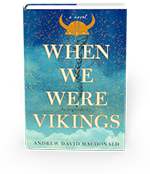
| Publisher: | Gallery/Scout Press | |
| Genre: | Humorous, General, Coming of Age, Literary, Fiction | |
| ISBN: | 9781982126766 | |
| Pub Date: | January 2020 | |
| Price: | $27 |
| Fiction |
by Andrew David MacDonald
Every so often a character transcends the page, leaping into readers' hearts; when this phenomenon coincides with the debut of a superbly talented author such as Andrew David MacDonald, it's even more extraordinary. In When We Were Vikings, MacDonald's captivating, beautifully written and witty novel, he introduces to the literary world an unforgettable protagonist.
Twenty-one-year-old Zelda has an intense fascination with Vikings and a diagnosis of fetal alcohol spectrum disorder. Both contribute mightily to her quirky, slightly naïve but almost always upbeat approach to life. All of this immediately endears her to readers. In the spirit of her revered Viking heroes and heroines, Zelda has embarked on a quest to become legendary. According to her favorite book, Kepple's Guide to the Vikings, she already has much of what she needs to accomplish her goal:
A powerful weapon? Her authentic Viking sword.
The love of a fair maiden? Zelda is in love with her boyfriend, Marxy, a young man who is also intellectually challenged and who agrees that they are ready to become sexually intimate.
A wise man? Her psychologist, Dr. Laird, has the credentials befitting that description, as does Viking expert Dr. Kepple, whom Zelda regularly e-mails in search of guidance on living as a modern-day Viking.
A tribe? Despite their unconventional circumstances, Zelda's family meets that criteria. She lives with her older brother, Gert, a well-intentioned but overwhelmed college student doing his best to care for Zelda after their mother's death from cancer, their father's unexplained disappearance, and her brief stay with an abusive uncle. Gert's on-again, off-again girlfriend--whose given name is Annie but whom Zelda calls AK47--also takes a protective, maternal role in Zelda's life, demonstrating that sometimes it is necessary to build one's own tribe with people who aren't related by blood.
A villain that she must defeat? When she discovers that Gert hasn't been attending his college classes--jeopardizing his scholarship in the process--and may be involved in some criminal activity, Zelda decides that this is her opportunity to take on a villain. "I know that people do things they do not want to do to contribute to the hoard. It is like a sacrifice, only instead of lighting things on fire or killing animals to make Odin and the other gods happy, you sacrifice yourself, and instead of doing the things you want to do, you have to do things for other people." Combating her villains also means defying her brother, but "sometimes the heroes of legends have to break the rules in order to save the people they care about."
With a fast-paced and engaging plot, MacDonald makes it easy for his readers to care deeply--and immediately--about Zelda. As the humorous and bittersweet storyline of When We Were Vikings progresses, readers will feel compassion for Zelda, while enthusiastically cheering her on to victory against the perceived dangers in her life.
Those perceived threats derive from other humans--namely, a drug dealer to whom Gert owes money--as well as from the discrimination and stigma that society perpetrates against people with disabilities. When We Were Vikings succeeds in shattering two gargantuan (one of Zelda's favorite words from her Word of Today calendar) misconceptions about people with disabilities: their capacity as employees and as sexual beings with the same desires and feelings as everyone else. When Zelda applies for a job at the local library, she senses her interviewer's reluctance to hire her, and is told that no positions are available. Similarly, when Zelda and Marxy announce their desire to have sex for the first time, the other adults in their lives respond with a range of emotions, from resistance to compassion.
"I also believed that part of my legend was to show the world that people like Marxy and me can be powerful together, the way that Gert and AK47 are powerful, and that we can create a tribe of our own one day," Zelda says. The beautifully creative way that their loved ones support them in taking this next step is a testament to MacDonald's skill, and his realistic and respectful handling of this theme marks him as a writer to watch.
The coming-of-age themes in When We Were Vikings are universally relatable. Like Zelda, many of us want our lives to have meaning and to be the stuff of legends. But, as Zelda learns, our journey toward greatness is uniquely our own, and it often doesn't look like the linear or logical outline in a guidebook. Rather, the way to become legendary is, as Zelda observes, "about taking all of the power that the gods have given you and making the most out of them."
With his stunning, heartfelt debut, Andrew David MacDonald has accomplished exactly that. When We Were Vikings sets him on a trajectory for a most legendary writing career. --Melissa Firman
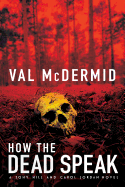
| Publisher: | Atlantic Monthly Press | |
| Genre: | General, Thrillers, Fiction | |
| ISBN: | 9780802147615 | |
| Pub Date: | December 2019 | |
| Price: | $26 |
| Mystery & Thriller |
by Val McDermid
In Val McDermid's riveting How the Dead Speak, a British convent-turned-orphanage for girls shuts down, and developers make a ghastly discovery while bulldozing the site: skeletal remains of 40 children.
The nuns and priest in charge of the orphanage have all been reassigned by the Catholic Church. A groundskeeper for the property claims he dug holes when the nuns told him to, nothing more.
Then remains of eight more victims are found under a flower bed on the same grounds, but these are fresher burials--and adult bodies. The groundskeeper lawyers up, the nuns deny everything, and the priest refuses to cooperate.
How the Dead Speak is part of the Tony Hill and Carol Jordan series, but this installment can be read as a gripping standalone. Fans will recall from the previous novel, Insidious Intent, that Hill and Jordan were removed from ReMIT, the Regional Major Incident Team. Though sidelined, both Hill and Jordan have subplots connected to the case.
Detective Chief Inspector Rutherford takes command of the team, but his methods create division. Local law enforcement seizes on ReMIT's disarray by taking charge of the orphanage crime scene. ReMIT must wrest control of the case while grappling with the frustrating secrecy of the Catholic Church. Luckily for the team, its master interviewer, DI Paula McIntyre, and unit tech specialist Detective Constable Stacey Chen are willing to go rogue with their own sharp instincts to catch the killer or killers. The team rallies behind these two and finally becomes a cohesive unit. McDermid gives a macabre storyline an unexpectedly emotional outcome. --Paul Dinh-McCrillis, freelance reviewer
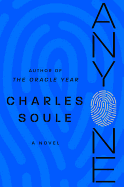
| Publisher: | Harper Perennial | |
| Genre: | General, Suspense, Supernatural, Thrillers, Fiction, Action & Adventure, Science Fiction | |
| ISBN: | 9780062890634 | |
| Pub Date: | December 2019 | |
| Price: | $21.99 |
| Mystery & Thriller |
by Charles Soule
A scientist's experiment gone wrong leads to a technology, called "flash," that changes the world. Charles Soule (The Oracle Year) gives this conventional sci-fi theme a rollicking 21st-century update in Anyone. While researching a cure for Alzheimer's disease, scientist Gabby White inadvertently discovers a process that allows one person's consciousness to take over the body of another. Years later, an enigmatic woman with a motive to subvert the technology is running for her life.
When she discovers flash in 2019, Gabby is under contract to a shady venture capitalist who owns her discovery. Its implications are so profound that she tries, with tragic results, to keep the discovery from him. "I'm telling you, the potential for abuse is horrible," she tells her husband as she plans to hide her work.
Twenty-five years later, when flash is ubiquitous, Annami, a brilliant technology worker with a hidden past, is planning to undermine the owner of the flash network, NeOnet Global. Their motto is "Be anyone with Anyone." Annami is "one of the few people who knew the truth behind the lie of the world, and the only one who seemed to want to make it right." When the money she needs to complete her plan is stolen, her fury propels her to take revenge on the perpetrators even as she continues the scheme to cripple NeOnet. Annami, both detective and enforcer, could be the next futuristic female heroine. Fans of N.K. Jemisin will devour this mind-bending novel. --Cindy Pauldine, bookseller, the river's end bookstore, Oswego, N.Y.

| Publisher: | Flatiron Books | |
| Genre: | Health & Healing, Cooking, Vegetables, Vegetarian, General, Specific Ingredients, Quick & Easy, Methods | |
| ISBN: | 9781250262882 | |
| Pub Date: | January 2020 | |
| Price: | $35 |
| Starred | Food & Wine |
by Jamie Oliver
Prolific cookbook writer and longtime TV personality Jamie Oliver has built a food empire on approachable, accessible cooking. Ultimate Veg: Easy & Delicious Meals for Everyone is Oliver's 23rd cookbook, eight years in the making and expansive in its collection of creative, healthy vegetarian recipes.
Novices and confident home cooks will enjoy Oliver's concise, clear recipes. He organizes Ultimate Veg by both recipe type and time of day, with sections like Curries & Stews; Pies, Parcels & Bakes; and Friday Night Nibbles. Selected standouts include Scruffy Eggplant Lasagne, Angry Pasta Fagioli and Speedy Egg-Fried Rice--all uncomplicated, delicious and aptly named. Reverse Puff Pastry Pizza is simple enough for dinner on a weeknight but impressive enough for a party--as are the smashing Rogan Josh Scotch Eggs. For gatherings, see shareables like the Ploughman's Nachos, Cheesy Kimchi Toastie or Supercharged Baba Ganoush. Dishes like the Phyllo Snake Bake or Double Corn Salad are rich in texture and whimsy (popcorn! on a salad!), destined to delight both kids and adults.
Where Oliver calls for any ingredients not strictly vegetarian, such as Parmesan cheese (which includes animal rennet) or Worcestershire sauce (anchovies), he suggests alternatives. He also offers tips about different fats, dairy alternatives, strategies for stocking a kitchen and notes on how to understand the nutritional guidelines included. Of the recipes in Ultimate Veg, 70% adhere to health guidelines provided within. The remainder are suited for occasional indulgence. As Oliver says, "Let your hair down and have a veg party!" --Katie Weed, freelance writer and reviewer
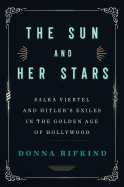
| Publisher: | Other Press | |
| Genre: | Biography & Autobiography, Women, Entertainment & Performing Arts, Jewish | |
| ISBN: | 9781590517215 | |
| Pub Date: | January 2020 | |
| Price: | $30 |
| Biography & Memoir |
by Donna Rifkind
"If Salka is remembered today, it's not for her screenwriting career or her role in the antifascist emigration; it's most often for her alleged lesbian relationship with Garbo," tuts Donna Rifkind in The Sun and Her Stars: Salka Viertel and Hitler's Exiles in the Golden Age of Hollywood.
A Jew raised in Galicia, Salka Viertel (1889-1978) had been a working actress for two decades when Hollywood came calling--for her Viennese theater director husband, Berthold. In 1928, the couple left Berlin for the U.S. In 1932, Viertel began working as a screenwriter for Metro-Goldwyn-Mayer, where her chief task was finding vehicles for Garbo. On Sundays, she hosted salons at her house in Santa Monica. Anyone in her circle of émigré artist friends might drop by for chocolate cake and conversation about the latest worrisome news from abroad.
Viertel wasn't content just to talk about the Nazi scourge. She procured the affidavits necessary for artists and others trying to flee persecution in Europe. She convinced her rich and famous friends to sponsor refugees, and she donated money to the cause. Becoming a U.S. citizen in 1939 emboldened her to do more. She took refugees into her home, tried to find them jobs and helped them to assimilate into the new world, as she had.
Rifkind proves with The Sun and Her Stars--her first book and the first English-language biography of Viertel--that she's a formidable storyteller. "Without immigrants, there would be no Golden Age of Hollywood," writes Rifkind. And without Salka Viertel, Old Hollywood's lights would have shone less brightly. --Nell Beram, author and freelance writer

| Publisher: | Ballantine Books | |
| Genre: | Biography & Autobiography, Women, Rural, Sociology, Personal Memoirs, Social Science | |
| ISBN: | 9781984818911 | |
| Pub Date: | January 2020 | |
| Price: | $27 |
| Biography & Memoir |
by Cassie Chambers
More a hopeful, somewhat guarded memoir than a hillbilly elegy, the debut book from crusading Kentucky lawyer Cassie Chambers charts, with wonkish warmth, its author's journey from the hollers and generational poverty of Owsley County, Ky., to the Ivy League--and then back again.
Chambers balances out her personal story with vivid portraiture of her Appalachian kin, especially her mother, the first of the family to go to college; her grandmother, who got married off at 15 to a 32-year-old man; and the hardy aunt who single-handedly keeps a family farm going until her 40s and then winds up working the register at the Family Dollar. Their voices ring out, frank and earthy, touched with King James but practical above all else: Chambers's Aunt Ruth declares to the man who comes to court her, "I just want you to know that if you ever put hands on me in anger, I'll have to kill you."
In its first half, as Chambers recounts breaking away from her home, Hill Women touches lightly on issues of mountain poverty and access to medical care. The second half finds the Harvard Law-trained Chambers returning to Kentucky to do legal work with domestic violence survivors. She faces the region's challenges with heartbreaking accounts of opioid addiction and a legal system less concerned with justice than it is with wringing money out of the broke and desperate. Like the hill women before her, Chambers is pragmatic, fighting for achievable change in a punishing system. --Alan Scherstuhl, freelance writer and editor
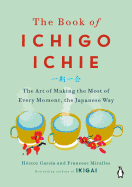
| Publisher: | Penguin | |
| Genre: | Self-Help, Personal Growth, Happiness, Mind & Body, Inspiration & Personal Growth, Body, Mind & Spirit, Philosophy | |
| ISBN: | 9780143134497 | |
| Pub Date: | December 2019 | |
| Price: | $22 |
| Starred | Psychology & Self-Help |
by Héctor Garcia, Francesc Miralles, trans. by Charlotte Whittle
Taking the time to notice simple moments amid busy lives often feels indulgent and impossible. In The Book of Ichigo Ichie, Héctor García and Francesc Miralles (co-authors of Ikigai: The Japanese Secret to a Long and Happy Life) show how the simple Japanese concept of recognizing the impermanence of our lives can lead to a deeper appreciation of our present.
Pronounced "itchy-GO itchy-A," the definition of ichigo ichie is imprecise. The term attempts to capture the understanding that "what we are experiencing right now will never happen again and therefore, we must value each moment like a beautiful treasure." Dating back to 1588 when first seen in writings by the tea master Yamanoue Sōji, ichigo ichie is a tenet of Zen Buddhism with relevance for the 21st century.
"Ichigo ichie depends on our ability to listen, see, touch, smell, and savor every moment, doing only one thing at a time, and putting our heart and soul into it, as if it were the last thing that we were going to experience on Earth."
Emotions such as anger, sadness and fear keep people stuck in the past and unable to recognize the beauty in the everyday. To help readers cultivate more moments of authentic experience and connection, García and Miralles use Japanese stories, legends and culture to illustrate the concept of ichigo ichie alongside suggestions for mindfulness techniques and easy to implement strategies to reduce distraction and "recover the power of attention." --Melissa Firman, writer and editor at melissafirman.com

| Publisher: | Grand Central | |
| Genre: | Biography & Autobiography, Composition, Authorship, Writing, Fiction Writing, General, Language Arts & Disciplines | |
| ISBN: | 9781538717950 | |
| Pub Date: | January 2020 | |
| Price: | $27 |
| Reference & Writing |
by Chuck Palahniuk
In the world of cult novelist Chuck Palahniuk, the success of a short story isn't always measured in sales figures. In some cases, a story's worth can instead be derived by how many people fainted during the author's live reading of the work. The story in question, "Guts," serves as one of many examples Palahniuk pulls from his own experience in this enlightening hybrid of memoir and writing insights.
Though that particular Palahniuk story did indeed lead to numerous instances of audience members losing consciousness when he started reading it aloud on tour in 2004, the author makes it clear that his interest lies not in shock but in subversion. Thus, there is no expectation that readers here be privy to the more intimate details of Palahniuk's work, although he does reference it often. Instead, many of the best lessons contained within Consider This derive from tips Palahniuk himself learned as a member of a writing workshop led by the writer Tom Spanbauer. To Spanbauer's credit, his workshop has launched a number of writing careers, including that of Palahniuk, who continues to meet weekly with a writing group.
Tackling subjects ranging from narrative authority to the passage of time, the Fight Club author references not only his own work but that of Nora Ephron, Margaret Mitchell and many others to great effect as he unflinchingly mines his past failures in hopes of steering readers in a different direction. Caustic and charming, Consider This is a worthy writing bible for even the most agnostic of writers. --Zack Ruskin, freelance reviewer
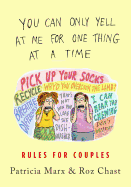
| Publisher: | Celadon | |
| Genre: | American, Form, Literary Criticism, Pictorial, Humor, Comics & Graphic Novels, Men, Women & Relationships, Marriage & Family, Humorous, Adult, Comic Strips & Cartoons, General, Topic | |
| ISBN: | 9781250225139 | |
| Pub Date: | January 2020 | |
| Price: | $20 |
| Humor |
by Patricia Marx, Roz Chast
Two New Yorker contributors--writer Patricia Marx and cartoonist Roz Chast--join forces in You Can Only Yell at Me for One Thing at a Time, 65 cartoons about love and relationships. Framed as an advice manual for people living together long-term, this collection showcases a diverse cast of characters united by love and annoyance.
Chast's signature black-and-white illustrations provide the visual and emotional context for captions such as "Earphones." In this cartoon, two women sit next to each other on a sofa, one rambling about traffic and spin class, the other happily ignoring her to listen to music. This sort of humor is consistent throughout, picking up at the point where the characters have moved past resentment and straight into an array of coping mechanisms.
The intentionally terrible advice in these cartoons provides readers with just those mechanisms, such as how to get your way: "Force yourself to say 'I love you.' It makes the other person feel guilty and that always works to your advantage." Despite the adversarial nature of the advice within, a strong undercurrent of affection runs through these cartoons. For example, how to be a good listener: "The answer to the question 'You know whatchamacallit who was dating the one with the father who had the business and there was that thing?' is yes."
Short and hilarious, this book is the perfect thing to leave in a very annoying place, such as in front of the microwave. --Suzanne Krohn, editor, Love in Panels
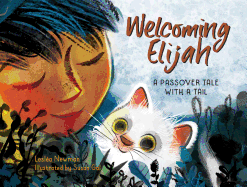
| Publisher: | Charlesbridge | |
| Genre: | Cats, Animals, Passover, Holidays & Celebrations, Religious, Juvenile Fiction, Jewish | |
| ISBN: | 9781580898829 | |
| Pub Date: | January 2020 | |
| Price: | $16.99 |
| Starred | Children's & Young Adult |
by Lesléa Newman, illust. by Susan Gal
Just as Jewish families open their doors for the prophet Elijah, Welcoming Elijah opens the Seder ritual and invites readers into the festivities. This heartwarming tale of a young boy and a tiny, stray kitten plays out entirely during the traditional meal as the story of the Exodus is retold and celebrated.
Lesléa Newman's (Gittel's Journey) poetic text alternates between the boy's perspective and that of the feline: "Inside, the boy drank grape juice./ Outside, the kitten lapped at a puddle." Inside, readers are engaged with the customs of a Jewish Seder, like filling Elijah's cup, dipping parsley into salt water and singing (the activities are discussed further in an author's note). Outside, the kitten mewls and swings its "skinny tail." Susan Gal's (Bella's Fall Coat illustrator) atmospheric illustrations reinforce the contrasting viewpoints: the child bathed in light and surrounded by family, the cat alone in the dark. This variance, paired with foreshadowing in the early pages--"Tonight would be different/ from all other nights./ The boy knew this./ The kitten did, too"--develops an intriguingly suspenseful tone. Gal's digital collage, charcoal and ink illustrations switch between hot and cool palettes, creating a sense of emotional warmth. Her superb use of line gives a fluidity to the art as well as a tactile impression of texture--readers will likely want to cuddle the furry white kitten with the silky pink ears. Meanwhile, anticipation builds for the moment the parallel paths of boy and kitten veer to intersect.
Together Newman and Gal immerse their audience in the beauty and joy of the Jewish service. This delightful, captivating Passover narrative can be appreciated by readers of any faith. --Jen Forbus, freelancer
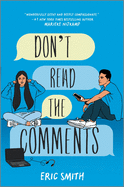
| Publisher: | Inkyard Press | |
| Genre: | Bullying, Computers & Digital Media, Romance, Multicultural & Interracial, Social Themes, Young Adult Fiction, Action & Adventure | |
| ISBN: | 9781335016027 | |
| Pub Date: | January 2020 | |
| Price: | $18.99 |
| Children's & Young Adult |
by Eric Smith
Bolstered by a supportive and defiant online community, two gamers bond as they defend what they cherish most in Eric Smith's Don't Read the Comments.
Divya Sharma loves streaming her adventures in the popular MMORPG Reclaim the Sun. Her fame (100,000 subscribers) earns her sponsorships that help pay the rent, but it also attracts trolls' vicious comments. Divya meticulously ignores them; they can't spoil the joy of questing with her "Angst Armada." She specifically enjoys Aaron Jericho, the novel's other narrator, whose goofy stories and sweet gestures in private chats keep her smiling. For Aaron, adventuring with Divya is a reprieve from his mom's insistence he become a doctor instead of a video game writer, a passion he pursues even though his boss never pays him. Overlooking the bullies becomes impossible, however, when Divya receives doxing threats. As a woman, she's hesitant to report online blackmail when real-life harassment goes unpunished--her streaming partner, Rebekah, was beaten by men who were never penalized despite a video of the attack going viral. But when men assault them at an arcade, Divya wants justice.
Through a compelling dual point-of-view narrative, Smith (The Girl and the Grove) skillfully addresses how the online sphere can serve as a breeding ground for hate--and how left unchecked, virtual harassment can lead to trauma. Yet through Aaron's endearing antics and Divya's devoted fleet of followers, Smith more powerfully illustrates the beauty, strength and solidarity of the gaming community. With an in-game romance to geek out over, a group of gamers fighting for their leader and copious video game references, Don't Read the Comments is a gratifyingly nerdy story about realizing dreams. --Samantha Zaboski, freelance editor and reviewer